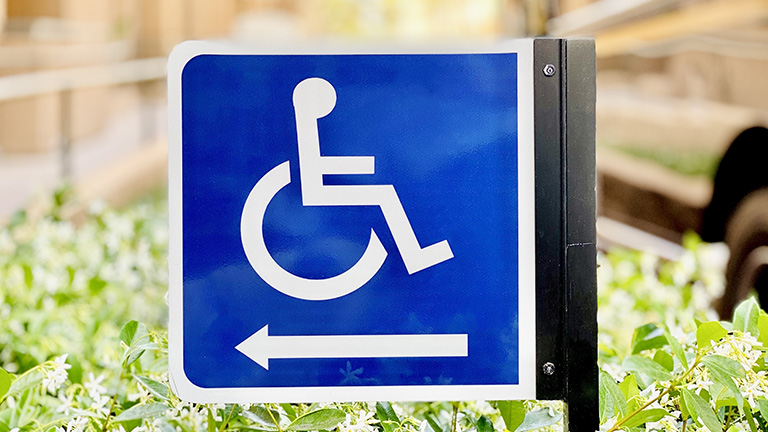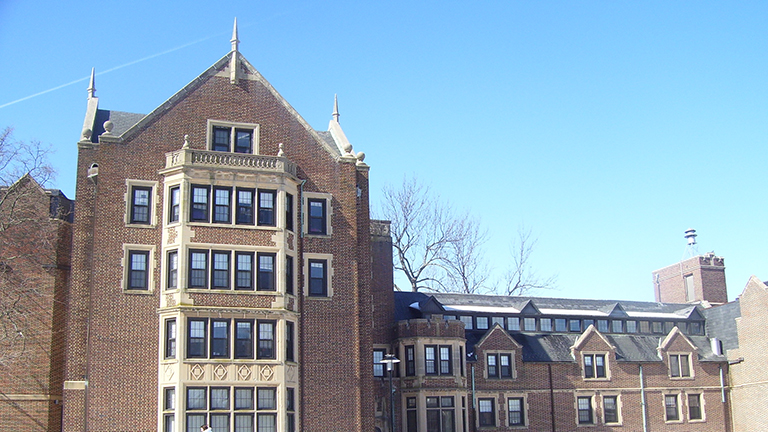Applicable ADA and ASME A18.1 Platform Lift Code
The Americans with Disabilities Act (ADA), founded in 1990, is U.S. civil rights legislation protecting the rights of persons with disabilities to take part in daily life without the need for additional assistance. The Americans with Disabilities Act Accessibility Guidelines (ADAAG), developed in coordination with the United States Access Board and the Department of Justice (DOJ), are the regulations by which the ADA is enforced. As such, these regulations provide scoping requirements for new construction sites, existing building alterations, and much more. Requirements dictate specifications for all accessible building features, including primary function areas, parking lots, ramps, elevators, and platform lifts.
When a platform lift is providing building access (i.e. is installed as part of an accessible route), it must comply with accessibility, building, and safety codes. Where the codes disagree, the most stringent usually applies, unless otherwise approved by the authority having jurisdiction (AHJ) – typically, local or state agencies. The following is an outline of the ADA Standards and the ADAAG as they pertain to platform lift accessibility requirements. However, this list is only an interpretation of the ADA standards and should NOT be considered as a comprehensive or authoritative guide to ADA requirements. Safety and accessibility code is constantly changing and new codes are being adopted throughout the U.S. often. Please contact your local building authority for further information. A state link is provided at the bottom of this page to reference state building codes and authorities.
2010 ADA Standards
- 2010 is the latest ADA version and references ADAAG 2004
- Per the ADA Standards 2010: State and local government facilities must follow the requirements of the 2010 Standards, including both the Title II regulations at 28 CFR 35.151; and the 2004 ADAAG.
- Per the ADA Standards 2010: Public accommodations and commercial facilities must follow the requirements of the 2010 Standards, including both the Title III regulations at 28 CFR part 36, subpart D; and the 2004 ADAAG.
2004 ADAAG (ADA Accessibility Guidelines)
- 2004 is the latest version
- References ASME A18.1-2003
- References International Building Code (IBC) 2003
- The US Access Board publishes an accessibility guide for buildings and facilities that includes guidance on platform lifts.
Chapter 2: Scoping Requirements detail where platform lifts can be used.
For new construction, wheelchair lifts are limited to applications listed in 206.7. For existing buildings and facilities, wheelchair lifts are permitted to be used as part of an accessible route. Rule 410 (detailed below) referenced in 206.7 is part of the ADAAG.
- 206.7 Platform Lifts. Platform lifts shall comply with 410. Platform lifts shall be permitted as a component of an accessible route in new construction in accordance with 206.7. Platform lifts shall be permitted as a component of an accessible route in an existing building or facility.
- 206.7.1 Performance Areas and Speakers’ Platforms. Platform lifts shall be permitted to provide accessible routes to performance areas and speakers’ platforms.
- 206.7.2 Wheelchair Spaces. Platform lifts shall be permitted to provide an accessible route to comply with the wheelchair space dispersion and line-of-sight requirements of 221 and 802.
- 206.7.3 Incidental Spaces. Platform lifts shall be permitted to provide an accessible route to incidental spaces which are not public use spaces and which are occupied by five persons maximum.
- 206.7.4 Judicial Spaces. Platform lifts shall be permitted to provide an accessible route to: jury boxes and witness stands; raised courtroom stations including, judges’ benches, clerks’ stations, bailiffs’ stations, deputy clerks’ stations, and court reporters’ stations; and to depressed areas such as the well of a court.
- 206.7.5 Existing Site Constraints. Platform lifts shall be permitted where existing exterior site constraints make use of a ramp or elevator infeasible.
- Advisory 206.7.5 Existing Site Constraints. This exception applies where topography or other similar existing site constraints necessitate the use of a platform lift as the only feasible alternative. While the site constraint must reflect exterior conditions, the lift can be installed in the interior of a building. For example, a new building constructed between and connected to two existing buildings may have insufficient space to coordinate floor levels and also to provide ramped entry from the public way. In this example, an exterior or interior platform lift could be used to provide an accessible entrance or to coordinate one or more interior floor levels.
- 206.7.6 Guest Rooms and Residential Dwelling Units. Platform lifts shall be permitted to connect levels within transient lodging guest rooms required to provide mobility features complying with 806.2 or residential dwelling units required to provide mobility features complying with 809.2 through 809.4.
- 206.7.7 Amusement Rides. Platform lifts shall be permitted to provide accessible routes to load and unload areas serving amusement rides.
- 206.7.8 Play Areas. Platform lifts shall be permitted to provide accessible routes to play components or soft contained play structures.
- 206.7.9 Team or Player Seating. Platform lifts shall be permitted to provide accessible routes to team or player seating areas serving areas of sport activity.
- 206.7.10 Recreational Boating Facilities and Fishing Piers and Platforms. Platform lifts shall be permitted to be used instead of gangways that are part of accessible routes serving recreational boating facilities and fishing piers and platforms.
207 Accessible Means of Egress
207.2 Platform Lifts. Standby power shall be provided for platform lifts permitted by section 1003.2.13.4 of the International Building Code (2000 edition and 2001 Supplement) or section 1007.5 of the International Building Code (2003 edition) (incorporated by reference, see “Referenced Standards” in Chapter 1) to serve as a part of an accessible means of egress.
NOTE: Where a platform lift is used as an accessible means of egress (exit from a building) it must have standby power for five full cycles with the intention that should a building lose power, individuals who cannot use stairs are still able to use the lift. This necessity is achievable through backup power provided by the facility, but is more often accomplished with a battery backup included with a lift by its manufacturer.
- Rule 410 covers platform lifts specifically. Note that platform lifts must be independently operable, so although ASME A18.1 safety code allows attendant-operated lifts where there are no controls on the platform, these lifts cannot be used as part of an accessible route. ASME A18.1 also applies to hand-crank units that are permitted for boarding trains but not for accessible routes in buildings.410 Platform Lifts
- 410.1 General. Platform lifts shall comply with ASME A18.1 (1999 edition or 2003 edition) (incorporated by reference, see “Referenced Standards” in Chapter 1). Platform lifts shall not be attendant-operated and shall provide unassisted entry and exit from the lift.
Advisory 410.1 General. Inclined stairway chairlifts and inclined and vertical platform lifts are available for short-distance vertical transportation. Because an accessible route requires an 80 inch (2030 mm) vertical clearance, care should be taken in selecting lifts as they may not be equally suitable for use by people using wheelchairs and people standing. If a lift does not provide 80 inch (2030 mm) vertical clearance, it cannot be considered part of an accessible route in new construction (a comparison list of wheelchair lifts is available on this website).The ADA and other Federal civil rights laws require that accessible features be maintained in working order so that they are accessible to and usable by those people they are intended to benefit. Building owners are reminded that ASME A18.1 Safety Standard for Platform Lifts and Stairway Chairlifts requires routine maintenance and inspections. Isolated or temporary interruptions in service due to maintenance or repairs may be unavoidable; however, failure to take prompt action to effect repairs could constitute a violation of Federal laws and these requirements.
410.2 Floor Surfaces. Floor surfaces in platform lifts shall comply with 302 and 303. See notes below regarding 302 and 303
410.3 Clear Floor Space. Clear floor space in platform lifts shall comply with 305. See notes below regarding 305
NOTE: A18.1 has a requirement for ¾” maximum spacing between the platform and the landing, which is narrower than the following ADA requirement.
410.4 Platform to Runway Clearance. The clearance between the platform sill and the edge of any runway landing shall be 1 1/4 inch (32 mm) maximum.
410.5 Operable Parts. Controls for platform lifts shall comply with 309. See notes below regarding 309
NOTE FOR THE FOLLOWING RULE: Many or most platform lifts are “straight-through” units (i.e., doors or gates are on opposite sides of the platform) and therefore do not have power operated doors or gates unless specifically requested by the customer or directed by the AHJ. Also, sometimes power-operated doors or gates are installed because the required maneuvering clearance (see rule 404.2.4 below) is not available, or there is a ramp at the entrance to the lift platform.
410.6 Doors and Gates. Platform lifts shall have low-energy power-operated doors or gates complying with 404.3. Doors shall remain open for 20 seconds minimum. End doors and gates shall provide a clear width 32 inches (815 mm) minimum. Side doors and gates shall provide a clear width 42 inches (1065 mm) minimum.
EXCEPTION: Platform lifts serving two landings maximum and having doors or gates on opposite sides shall be permitted to have self-closing manual doors or gates.
- Sections 302-309 provided here are outlines of portions referenced by Chapter 4 of the ADAAG, as they supply more detailed spacing regulations.
Section 302, Floor or Ground Surfaces (as referenced by 410 above) require slip-resistant and stable flooring for platform lifts (302.1). Also, openings in the surface must reject a ½”-diameter sphere, except at the entrance and exit to landings (302.3).
Section 303, Changes in Level (as referenced by 410 above): according to rules 303.2 and 303.3, changes in level up to ¼” are permitted to be vertical, and changes in level more than ¼” but less than ½” are permitted to be beveled at a slope not steeper than 1:2. Additionally, rule 303.4, requires changes in level of more than ½” to be ramped in compliance with 405, which specify a slope not exceeding 1:12. These restrictions on level changes are important for platform lifts when a lift is floor-mounted at the lower landing as there will be a level change from the lower landing to the platform floor, and these restrictions will apply. The typical level change is 2-3” for a “tower-style” lift, although some lifts offer a level change of as little as ½”.Unless the lift frame and platform floor are recessed into an installation pit at lower level, there will be a level change at the lower level entrance. Some jurisdictions require that all lifts must be recessed. For a list of platform lift comparisons, see our link here.
NOTE: ASME A18.1 safety code in Section 2.1.5 (2003 version) allows steeper ramp slopes, up to 1:4 for some applications. While the A18.1 safety code may allow a steeper slope, if the platform lift is being used as part of an accessible route, the more stringent ADAAG requirement takes precedence.
Section 305 Clear Floor or Ground Space (as referenced by 410 above): 305.3 states that the clear floor or ground space shall be 30 inches minimum by 48 inches minimum, which at first glance appears to indicate that the minimum clear floor space for a platform lift is 30” x 48”. However, this is not the case, as 305.7, Maneuvering Clearance, states that where the clear floor space is located in an alcove or otherwise confined on all or part of three sides, additional maneuvering clearance shall be provided. The clear floor space of a platform is confined in such a manner. Accordingly, per 305.7.1 Forward Approach, the minimum clear width for a straight-through platform lift is 36”, constituting a 36”x48” minimum clear floor space for a straight-through platform lift. Similarly, per 305.7.2 Parallel Approach, the minimum long dimension for a 90-degree platform lift is 60”. Meaning the minimum clear floor space for a 90-degree platform lift is to be 36” x 60”.
Section 309 Operable Parts (as referenced by 410 above): 309.3 Height states, operable parts shall be placed within a reach range specified in 308 – 15” to 48” above the floor for most all layouts likely to be encountered in a platform lift. Rule 309.4 Operation states, “all operable parts shall be operable with one hand and shall not require tight grasping, pinching, or twisting of the wrist.” Also, the force required to operate the control shall not exceed five (5) pounds.
NOTE: When lifts are used as part of an Accessible Route, as permitted in Section 206.7, they must comply with all applicable parts of Chapter 4: Accessible Routes, not just Rule 410.
404.2.3 Clear Width states that door openings shall provide a minimum clear width of 32 inches. The clearance is measured from the door surface when it is opened 90 degrees to the opposite door frame.
404.2.4 Maneuvering Clearances for manual doors and gates requires 60 inches perpendicular clear space and 18 inches parallel clearance beside the door latch or handle when a platform lift’s door or gate is approached from the front. Parallel approaches require even more space.
NOTE: Failure to provide the required clearance beside the door latch (18”) is a common problem, whether due to a design error or site constraints in alterations of existing facilities. One mitigating factor is Rule’s 404.2.4.3 allowance of doors and gates to be recessed up to 8 inches without the latch clearance.
404.2.8 Closing Speed specifies doors with door closers can move from 90 degrees to 12 degrees in no less than five seconds. Doors with spring hinges can move from 70 degrees to full close in no less than 1.5 seconds.
404.2.9 Door and Gate Opening Force specifies a maximum opening force of five (5) pounds. This applies only to the continuous force required to open the door; the force required to overcome initial door inertia can be greater or to disengage closing devices can be greater.
404.2.10 Door and Gate Surfaces requires a 10 inch high smooth kick panel on the push side of a swing door or gate.
404.3 Automatic and Power-Assisted Doors and Gates requires full-powered automatic doors to comply with ANSI/BHMA A156.10. The maneuvering clearances required for manual swing doors in 404.2.4 are eliminated unless the platform lift is on an accessible means of egress and standby power is not provided.
State and Local Codes:
Though local code standards are derived from federal regulations, there are often many differences (the Department of General Services provides a succinct explanation as to why this is the case). However, where codes conflict, the more stringent code has precedence, unless otherwise authorized by the AHJ.
U.S. state building codes are adopted through the International Code Council (ICC) which publishes the IBC and updates every three years. These codes are adopted and implemented statewide, often with amendment. Currently, all 50 U.S. states have integrated, in one form or another, the IBC. With regard to accessibility, the ICC operates as the secretary of the American National Standards Institute (ANSI) A117.1 (a standard for Accessible and Usable Buildings and Facilities), which the ICC references in the IBC. For further information regarding the interconnection and relativity of the IBC and ADAAG, the ICC provides an informative brochure.
The following is a state-by-state link to U.S. building code adoptions and the authorities to which they belong:
Additional Information:
The ICC A117.1 Accessible and Usable Buildings and Facilities Code:
-
- ICC A117.1-2009 is the current version.
- A117.1 is similar to the ADAAG. A building that complies with A117.1 will also comply with ADAAG. Some parts of A117.1 are more stringent than ADAAG.
- Because the A117.1 is in close alignment with the ADAAG, most of the comments in the ADAAG section of this website apply to A117.1 as well. The exceptions are noted below.
- Differences between A117.1 and ADAAG:
- ADAAG references ASME A18.1-2003. A117.1-2009 references ASME A18.1-2005.
NOTE: ADAAG and A117.1 are both accessibility codes, whereas ASME A18.1 is a safety code.
-
-
- ASME A18.1-2005 code contains a summary of changes from the 2003 to 2005 versions.
- Code officials and AHJs inspecting for compliance to an accessibility code such as A117.1 or ADAAG will typically accept equipment that complies with a newer version of ASME A18.1 than is referenced in the accessibility code, as long as their jurisdiction has already adopted the newer ASME A18.1 standard as its safety code.2.Section 410.2 Lift Entry. For a lift with one door on the narrow end and the other door on the long side of the lift platform, the clear door opening requirements in A117.1 are more stringent than in the ADAAG:
- A117.1 mandates the door on the narrow end must have a clear opening width of 36” minimum. Conversely, ADAAG requires 32” minimum.
- A117.1 mandates the door on the long side must have a clear opening width of 42” and be located with its latch or hinge in the corner of the platform farthest from the narrow door. ADAAG does not specify the location of the latch or hinge, though Figure 410.6 in ADAAG does match the door location specified in A117.1.
- A117.1 Section 410.5 Clear Floor Space explicitly states the minimum clear floor space for lifts with doors on opposite ends as 36” x 48”. Conversely, ADAAG requires this only by reference to floor space requirements in alcoves. In addition, A117.1 requires 36”x60” minimum clear floor space for lifts with doors on adjacent sides in existing construction and 42”x60” minimum clear floor space in new construction. The ADAAG requires 36”x60” for alterations as well as new construction.
-
ASME A18.1 Safety Standard for Platform Lifts and Stairway Chairlifts:
A Short History of A18.1 and Safety Progress
The first version of ASME A18.1 Safety Standard for Platform Lifts and Stairway Chairlifts was issued in 1999. Prior to that time, platform lifts and stairway chair lifts were covered under Parts 20 and 21 of ASME A17.1 Safety Code for Elevators and Escalators. Since 2005, new versions of A18.1 have been issued at three year intervals. Each version of the safety standard lists the changes that have been incorporated in that version.
Purpose
According to the foreword in ASME A18.1-2014, the standard is intended to serve as the basis for state, municipal, and other jurisdictional authorities in drafting regulations governing the installation, testing, inspection, maintenance, alteration, and repair of platform lifts and stairway chairlifts. In other words, the standard is not law in and of itself; rather, it is adopted by individual jurisdictions, with or without modifications. The only other standard that is currently used as a basis for lift safety laws in the United States is ASME A17.1 Safety Code for Elevators and Escalators from 1996 or before.
Be Aware of State and Local Use
Many jurisdictions modify the standard when they implement their platform lift safety law, so one always needs to check the laws in a given jurisdiction before assuming that the whole of A18.1 applies. For instance, a few states do not allow unenclosed lifts, even though this type of lift is covered by section 2.1.3 in A18.1
Also, it is important to be aware of which edition of the standard is enforced in a given jurisdiction, since many places use an older version. For instance, while the current ASME A18.1 edition is from 2014, the 2003 version is still in effect in California, and the 2005 version is the law in New York State. There are technical differences between editions, so referring to the wrong one for a given jurisdiction could lead to costly mistakes, such as purchasing and installing equipment that doesn’t meet the law.
Additionally, ASME A18.1 has requirements for lifts in both commercial and residential settings. Requirements for residential lifts are generally less stringent than for commercial lifts because access to the lifts is often more restricted. Many jurisdictions do not even regulate or inspect residential lifts.
Portable Lifts and A18.1
Portable equipment is specifically exempted from A18.1 under rule 1.1.2(e). This includes wheeled vertical platform lifts that can be moved from one location to another and then set up for use.
Jurisdictions have handled this exemption in several ways. Most jurisdictions do not inspect or regulate portable lifts because they are exempt from the A18.1 code; however, a few jurisdictions require special variances for portable lifts, while several others have written their own regulations for portable models.
Because portable lifts are not regulated in most jurisdictions, some portable units on the market are missing critical safety devices required by A18.1. Two of the most commonly omitted safety features are platform gates and an under-platform safety pan. Platform gates prevent the user from rolling or falling out of the platform when the platform is not at ground level; the platform underpan stops the downward motion of the lift platform if it encounters an obstruction while descending.
Portable lifts also vary in their level of accessibility. For example, because portable lifts cannot be recessed into a pit, an access ramp is provided at the lower landing. Depending upon how close the platform can get to ground level, this access ramp can be quite steep, and almost impossible for some wheelchair users to negotiate independently. A18.1, as a safety code, allows steep ramps that are not allowed by the accessibility codes ADAAG or ICC A117.1. However, there are some lifts which provide low profile platform floor access which is easily negotiated by virtually all users.
Where to Find a Copy
Though copies of some editions may be found online for free, for interested parties, ASME A18.1 is available for purchase through the American Society of Mechanical Engineers website.
Filing a complaint:
If for any reason you find yourself or someone you know discriminated against due to a disability or encounter a situation which conflicts with ADA regulations, you may file a complaint with the Department of Justice Civil Rights Division.



